Every year, Salience reports on the digital strength of the online plant industry to discover who has blossomed and who has wilted away (sorry not sorry) in terms of online visibility and digital brand strength. Last year, we featured Patch Plants, who wowed us and their customers with their educational content and understanding of SEO. So, who is the big climber of 2020-2021?
Although 2020-2021 was much more measured after the huge industry boom in 2019-2020, there are still some brands that kept up the momentum. Tree2mydoor is a family-run business based in Manchester that is the star of our visibility chart. With around a 300% visibility increase YoY, even accounting for huge changes in the market due to COVID, this is impressive work.
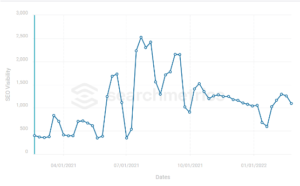
If you don’t know, visibility is a term that refers to a wide range of metrics that make up how much Google likes your site and, therefore, how likely it is to promote your site in searches. Improving things like page loading speed, SEO content, product depth, and general site health will help bring you up in relevant searches and means more people will find you.
Create an Informed Customer Pathway
Tree2mydoor is another business that has strong SEO foundations. Just like Patch, they also have a wealth of educational content on their blog, which provides a lot of the pages with the most traffic. This awareness content means that they can capture people who are searching for information about a tree or plant before they purchase one, bringing them to the site where they will hopefully convert this interest into a transaction.
When looking at improved keyword rankings over 2020-2021, tree2mydoor ranks top 20 for around 800 keywords because of their care guides, such as the bay tree care guide, which is one of the top performers on traffic and ranks top 20 for 75 keywords. Their extensive and informative pages are building a network of authority around the subject that means they have rankings for generic terms like “oak tree”, which have high competition.
There is good internal linking between the care guides and the related products, which means that customers can easily go between getting their questions answered and making a transaction. Tree2mydoor also includes all the information you could need about your purchase on the product page:
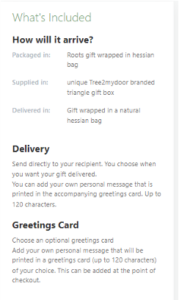
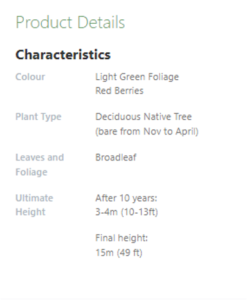
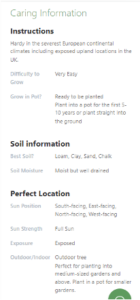
Alongside reviews, this is a great way to capture customers at all stages of the buying process.
Show Your Content
An extensive product depth is always helpful, but you also have to understand how to signpost your products and have a clear site structure. Tree2mydoor have a great blog that is generating organic traffic, but the on-site navigation could still be improved. We would highly recommend adding guide content to the meganav so that it is easily found by users. Here are two great examples from our Clients, Dreams (left) and Bert and May (right), who have their advice and information sections within their meganavs.
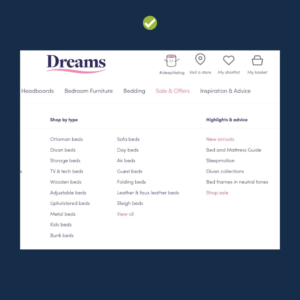
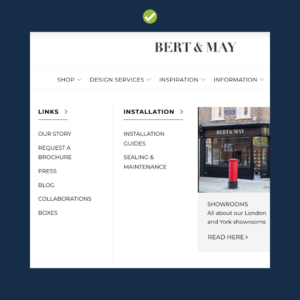
Implementing this provides a great opportunity for improving internal linking, building authority, and increased useability.
Another way to ensure Google is crawling through your website properly is to make sure that you use headers correctly. This means formatting the content so that Google and users can quickly and easily see the information that is on that page.
Here is an example from tree2mydoor’s home page:
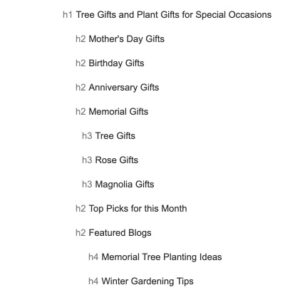
Although “Tree Gifts and Plant Gifts for Special Occasions” isn’t the first header on the page, they have made sure to make it the H1, which means that Google will crawl it as the most important title on the page.
There is also a huge number of H2, H3, and H4 headers, which give structure to the content and allow Google to scan for keywords and understand what your site is all about and what is on offer. By putting your keywords, such as the different plant gifts and occasions, as headers, you are showing Google that you should rank for these terms.
Are tags #over?
When it comes to your site, the more organised it is, the better – for both Google and your users. However, there are some questions about the value of blog tags. As we can see here, tree2mydoor uses a lot of tags on each of their blog posts:
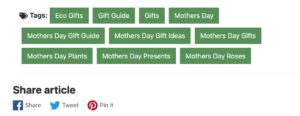
These are great for navigating through their blog but do these add any SEO value? Ultimately, no. Google doesn’t crawl these, so adding “lemon tree” and “lemon trees” is redundant. In fact, it could actually hurt your score as the same content will be under both tags and end up creating a page with duplicate content. This will create a cannibalisation problem that can cause issues with Google and visibility because it will be confused about which page to rank, which will cause both to drop. When it comes to blog tagging, the best practice is to use it purely for user navigation, so don’t overcomplicate it and look out for potential repetition.
Best practice recommendations for reorganising for better useability is to create subcategories, which are more easily navigated than the tagging system. Dreams’ blog, Sleep Matters Club, is another great example of clear organisation.
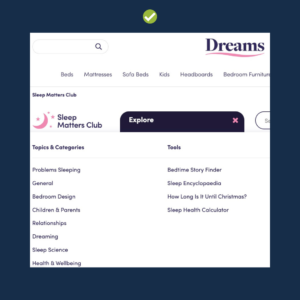
This essentially uses the same ideas as tagging does but is more sophisticated and creates hubs of information, rather than expecting users to follow the tags to get to where they want. Again, this also signals to Google what your site has on offer and makes it clear which pages should be ranking for terms, and gives a nice authority boost.
Final word
Overall, while tree2mydoor.com is not a huge name in the online plant landscape, it doesn’t mean that they aren’t ones to watch and learn from. If your visibility score and online presence is lacking, then this site has some great functionality and understanding of SEO that has contributed to their huge boost this year.
Remember, it’s all about signposting what you do and making it easy for Google and customers to move through the process of being interested in a product to purchasing all within your site. Site authority is built through showcasing your expertise and making it easy for users to find the information that they want and need.
BONUS FACT: Stanford Collage released a web credibility doc over 20 years ago, those guidelines still standup today.
Interested in more information? Download our 2021 plant industry report or request a free digital audit from us today and find out how we can help make your brand thrive online
